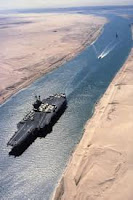Egypt's Suez Canal Still Open to Shipping as Protesters Gathering in Cairo
Egypt’s Suez Canal, used to carry about eight percent of global seaborne trade, was operating normally today amid mounting protests against the government, according to an official from the waterway.
56 vessels are passing through the canal, more than the average of about 50, Ahmed El Manakhly, head of traffic for the Suez Canal Authority, said in an interview with Andrea Catherwood on Bloomberg TVs “The Pulse.” Working hours have been adjusted to comply with a curfew and the military hasn’t deployed to the canal, he said.
“The traffic through the Suez Canal hasn't been affected by the prevailing situation in Egypt,” El Manakhly said. “Traffic from Port Said at the northern entrance of the canal or from Suez at the southern entrance is going with normal rate and with the same and the usual schedule.”
Egypt’s Suez Canal, used to carry about eight percent of global seaborne trade, was operating normally today amid mounting protests against the government, according to an official from the waterway.
56 vessels are passing through the canal, more than the average of about 50, Ahmed El Manakhly, head of traffic for the Suez Canal Authority, said in an interview with Andrea Catherwood on Bloomberg TVs “The Pulse.” Working hours have been adjusted to comply with a curfew and the military hasn’t deployed to the canal, he said.
“The traffic through the Suez Canal hasn't been affected by the prevailing situation in Egypt,” El Manakhly said. “Traffic from Port Said at the northern entrance of the canal or from Suez at the southern entrance is going with normal rate and with the same and the usual schedule.”
The waterway is the fastest crossing from the Atlantic Ocean to the Indian Ocean, according to the Suez Canal Authority. Should it close, tankers would have to sail around southern Africa. That would add about 12 days to a journey from Saudi Arabia to Houston, Luis Mateus, an analyst at Riverlake Shipping SA in Geneva, estimated last week.
Opposition supporters today poured into Cairo’s Tahrir Square, the epicenter of the weeklong uprising against the President Hosni Mubarak’s 30-year rule. Newly appointed Vice President Omar Suleiman said late yesterday that Mubarak instructed him to start a dialogue with the protesters. The military promised not to fire on marchers and said that it recognized “the legitimacy of the people’s demands.”
Container Line
A.P.Moeller-Maersk A/S, the container shipping line and terminal operator, kept offices closed in Egypt today and deployed only an emergency staff at Port Said, Michael Storgaard, a spokesman for the Copenhagen-based company, said by e-mail today. Maersk has about 7,000 employees in Egypt.
Frontline Ltd., the world’s largest operator of supertankers, said yesterday that a closure of the canal was unlikely, although delays were possible. The company isn’t aware of any plans to divert ships, Jens Martin Jensen, chief executive officer of the management unit of Frontline, said by phone from Singapore.
A vessel going from Saudi Arabia to Rotterdam can cut the distance traveled by about 42 percent by using the canal rather than sailing around the Cape of Good Hope, data on the canal authority’s website show. To southern France the saving is 57 percent and to NY 30 percent, the data show.
Goldman Sachs
The canal has the capacity to handle 2.2 million barrels of oil a day while that of the adjacent Suez-Mediterranean Pipeline is 2.3 million barrels, according to Goldman Sachs Group Inc. Actual volumes in 2009 were a combined 2.1 million barrels because of cuts in production by the Organization of Petroleum Exporting Countries, the bank said.
The canal was previously closed for 4 months in 1956-57 and for 8 years from 1967, Barclays said. The closure of the canal this time would remove about 2 million to 3 million barrels of oil and about 2 million barrels of refined products a day, the bank estimates. Much of the northbound oil goes to refineries in the Mediterranean.

No comments:
Post a Comment